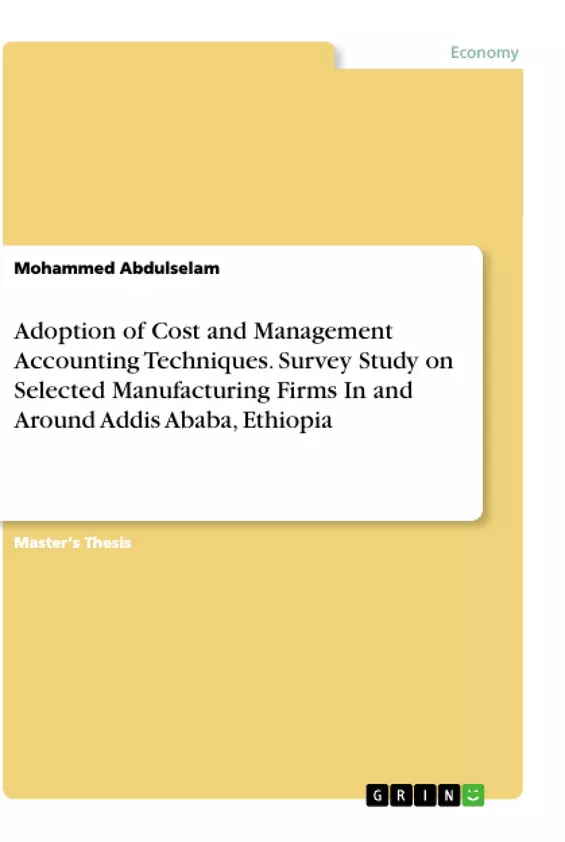This study attempts to investigate the degree of Adoption of cost and management accounting techniques in Selected Manufacturing companies in and around Addis Ababa, Ethiopia. Further, factors affecting the adoption of those techniques were examined. Finally, the perceived effect of adopting these techniques on the company’s operating efficiency and financial performance were evaluated. In doing so, Descriptive and explanatory research design were used for achieving multi-dimensional objectives of this study.
Simple Proportional Allocation stratified sampling Technique was employed for determining the sample size from each stratum of manufacturing firms. Total sample of 91 manufacturing firms in and around Addis Ababa were included in this study & structured survey Questionnaires were distributed to each of them. Consequently, 65 usable Questionnaires were collected back and used for analysis and discussion of results. The finding of this study revealed that, currently selected Ethiopian manufacturing firms in study area are gradually adopting cost and management accounting techniques.
In today’s competitive world of business, having accurate information is the key factor in distinguishing between the loser and the winner. Cost and management accounting embraces a range of techniques essential to all phases of product life cycle from providing reliable information for strategic decision making to managing construction and maintenance of costs.
Inhaltsverzeichnis (Table of Contents)
- CHAPTER ONE
- INTRODUCTION
- Background of the Study
- Back ground of Manufacturing firms in Study Area
- Statement of the Problem
- Research Questions
- Objectives of the Study
- General Objectives
- Specific Objectives
- Research Hypothesis
- Significance of the Study
- Scope or Delimitation of the Study
- Organization of The paper
- CHAPTER TWO
- REVIEW OF RELATED LITERATURES
- Theoretical Review
- Cost and Management Accounting Purposes and Evolution
- Traditional Cost and Management Accounting Techniques
- Standard Costing
- Comparison of Traditional Costing Techniques
- Modern Cost and Management Accounting Tools
- Activity Based Costing / Activity Based Management
- Life Cycle Costing or Life Cycle Management
- Cost and Management Techniques for Quality and Performance Measurement
- Kaizen Improvement or Management
- Just in Time (JIT)
- Balanced Sore Card
- Empirical Review of Literature
- Empirical Studies from The World Countries
- Empirical Studies from Ethiopia
- Research Gap
- CHAPTER THREE
- RESEARCH DESIGN AND METHODOLOGY
- Research Design
- Source of Data and Data Collection Techniques
- Primary Data
- Secondary Data
- Data Collection Instruments
- Target Population and Sampling Methods
- Sample Design
- Sample Size and Sampling Techniques
- Method of Data Analysis and Presentation
- CHAPTER FOUR
- RESULT AND DISCUSSION
- Introduction
- Analysis of Finding Related to Respondent Firms Characteristics/profiles
- Analysis of Results for Respondent Employee's Profile
- Descriptive Statistics Analysis
- Cost and Management Accounting Techniques Adopted and implemented
- Purpose of Cost and Management Accounting information for Managers
- Results and Analysis for Effect of Adopting CMATs on Financial Performance
- Results and Analysis for Effect of Adopting CMATs on Companies Operating Efficiency
- Inferential Statistics Results
- Factors affecting the adoption of cost and management accounting techniques in selected manufacturing firms in and around Addis Ababa
- Correlation results and analysis
- Tests for Multicollinearity
- Multiple regression analysis results and discussion
Zielsetzung und Themenschwerpunkte (Objectives and Key Themes)
This research thesis investigates the adoption of cost and management accounting techniques in selected manufacturing companies in and around Addis Ababa, Ethiopia. It aims to understand the degree of adoption, factors influencing adoption, and the perceived effects on operational efficiency and financial performance.
- Adoption of cost and management accounting techniques in Ethiopian manufacturing firms.
- Factors influencing the adoption of these techniques.
- Impact of cost and management accounting adoption on company performance.
- Comparison of traditional and modern cost accounting approaches.
- The role of cost and management accounting in enhancing business competitiveness.
Zusammenfassung der Kapitel (Chapter Summaries)
- Chapter 1: Introduction This chapter provides a background to the study, outlines the problem statement, research questions, objectives, significance, and scope of the research. It introduces the context of cost and management accounting in Ethiopian manufacturing firms and highlights the research's relevance.
- Chapter 2: Review of Related Literatures This chapter delves into the theoretical and empirical literature related to cost and management accounting. It examines the evolution of these techniques, explores traditional and modern approaches, and reviews previous studies on adoption and impact in different contexts.
- Chapter 3: Research Design and Methodology This chapter describes the research design, data sources, data collection methods, and analysis techniques employed in the study. It outlines the target population, sampling method, and the specific data collection instruments used.
- Chapter 4: Result and Discussion This chapter presents the findings of the study, analyzing the descriptive statistics and inferential statistics results. It examines the characteristics of the respondent firms, their adoption of cost and management accounting techniques, and the factors affecting adoption. The chapter also analyzes the impact of adoption on company performance.
Schlüsselwörter (Keywords)
This research focuses on the adoption of cost and management accounting techniques in Ethiopian manufacturing firms. Key terms include cost accounting, management accounting, budgeting control techniques, throughput accounting, operating efficiency, and financial performance.
- Quote paper
- Mohammed Abdulselam (Author), 2017, Adoption of Cost and Management Accounting Techniques. Survey Study on Selected Manufacturing Firms In and Around Addis Ababa, Ethiopia, Munich, GRIN Verlag, https://www.grin.com/document/1009527



